Zero-Watermarking for Vector Maps Combining Spatial and Frequency Domain Based on Constrained Delaunay Triangulation Network and Discrete Fourier Transform
Abstract
1. Introduction
2. Related Works
3. Methodology
3.1. Data Preprocessing
3.2. Spatial Domain Statistical Information Mining Based on CDTN
3.3. Feature Information Construction Based on DFT
3.4. Procedure of the Proposed Zero-Watermarking
3.5. Watermark Detection
4. Results and Discussion
4.1. Experimental Results
4.1.1. Watermark Encryption
4.1.2. Zero Watermark Construction
4.2. Robustness Evaluation
4.2.1. Geometric Attacks
4.2.2. Cropping Attacks
4.2.3. Points Attacks
4.2.4. Coordinate System Transformation Attacks
4.3. Comparative Analysis
5. Conclusions
Author Contributions
Funding
Data Availability Statement
Acknowledgments
Conflicts of Interest
References
- Usman, M.; Jan, M.A.; He, X.; Chen, J. A survey on big multimedia data processing and management in smart cities. ACM Comput. Surv. 2019, 52, 1–29. [Google Scholar] [CrossRef]
- Abubahia, A.; Cocea, M. Evaluating the topological quality of watermarked vector maps. Appl. Soft. Comput. 2018, 71, 849–860. [Google Scholar] [CrossRef]
- Xu, X.; Zhang, X. Reversible watermarking for vector maps based on interval mapping and maximum perturbation region. J. Geod. Geoinf. Sci. 2022, 52, 2379–2389. [Google Scholar]
- Pham, G.N.; Ngo, S.T.; Bui, A.N.; Tran, D.V.; Lee, S.H.; Kwon, K.R. Vector map random encryption algorithm based on multi-scale simplification and Gaussian distribution. Appl. Sci. 2019, 9, 4889. [Google Scholar] [CrossRef]
- Wang, X.; Shao, C.; Xu, X.; Niu, X. Reversible data-hiding scheme for 2-D vector maps based on difference expansion. IEEE Trans. Inf. Forensics Secur. 2007, 2, 311–320. [Google Scholar] [CrossRef]
- Jang, B.J.; Lee, S.H.; Kwon, K.R. Perceptual encryption with compression for secure vector map data processing. Digit. Signal Process. 2014, 25, 224–243. [Google Scholar] [CrossRef]
- Serra-Ruiz, J.; Qureshi, A.; Megías, D. Entropy-based semi-fragile watermarking of remote sensing images in the wavelet domain. Entropy 2019, 21, 847. [Google Scholar] [CrossRef]
- Wang, N.; Men, C. Reversible fragile watermarking for 2-D vector map authentication with localization. Comput. Aided Design 2012, 44, 320–330. [Google Scholar] [CrossRef]
- Zhu, C. Research progresses in digital watermarking and encryption control for geographical data. J. Geod. Geoinf. Sci. 2017, 46, 1609–1619. [Google Scholar]
- Yang, Z.; Sun, Q.; Qi, Y.; Li, S.; Ren, F. A Hyper-Chaotically Encrypted Robust Digital Image Watermarking Method with Large Capacity Using Compress Sensing on a Hybrid Domain. Entropy 2022, 24, 1486. [Google Scholar] [CrossRef]
- Cedillo-Hernandez, M.; Cedillo-Hernandez, A.; Nakano-Miyatake, M.; Perez-Meana, H. Improving the management of medical imaging by using robust and secure dual watermarking. Biomed. Signal. Proces. 2020, 56, 101695. [Google Scholar] [CrossRef]
- Wang, C.; Wang, X.; Xia, Z.; Zhang, C. Ternary radial harmonic Fourier moments based robust stereo image zero-watermarking algorithm. Inform. Sci. 2019, 470, 109–120. [Google Scholar] [CrossRef]
- Wang, B.; Shi, J.; Wang, W.; Zhao, P. Image copyright protection based on blockchain and zero-watermark. IEEE Trans. Netw. Sci. Eng. 2022, 4, 2188–2199. [Google Scholar] [CrossRef]
- Cox, G.S.; Jager, G. A Survey of Point Pattern Matching Techniques and a New Approach to Point Pattern Recognition. In Proceedings of the 1992 South African Symposium on Communications and Signal Processing, Cape Town, South Africa, 1 September 1992; pp. 243–248. [Google Scholar]
- Wang, C.; Peng, Z.; Peng, Y.; Yu, L.; Wang, J.; Zhao, Q. Watermarking geographical data on spatial topological relations. Multimed. Tools Appl. 2012, 57, 67–89. [Google Scholar] [CrossRef]
- Tong, D.; Zhu, C.; Ren, N. Watermarking algorithm applying to small amount of vector geographical data. Acta Geod. Cartogr. Sin. 2018, 47, 1518–1525. [Google Scholar]
- Lee, S.H.; Kwon, K.R. Vector watermarking scheme for GIS vector map management. Multimed. Tools Appl. 2013, 63, 757–790. [Google Scholar] [CrossRef]
- Peng, Z.; Yue, M.; Wu, X.; Peng, Y. Blind watermarking scheme for polylines in vector geo-spatial data. Multimed. Tools Appl. 2015, 74, 11721–11739. [Google Scholar] [CrossRef]
- Abubahia, A.; Cocea, M. Advancements in GIS map copyright protection schemes—A critical review. Multimed. Tools Appl. 2017, 76, 12205–12231. [Google Scholar] [CrossRef]
- Zhu, C.; Ren, N.; Xu, D. Geo-information security technology: Progress and prospects. Acta Geod. Cartogr. Sin. 2022, 51, 1017–1028. [Google Scholar]
- Ren, N.; Zhao, M.; Zhu, C.; Sun, X.; Zhao, Y. Commutative encryption and watermarking based on SVD for secure GIS vector data. Earth Sci. Inform. 2021, 14, 2249–2263. [Google Scholar] [CrossRef]
- Xi, X.; Zhang, X.; Sun, Y.; Jiang, X.; Xin, Q. Topology-preserving and geometric feature-correction watermarking of vector maps. IEEE Access 2020, 8, 33428–33441. [Google Scholar] [CrossRef]
- Ren, N.; Zhao, Y.; Zhu, C.; Zhou, Q.; Xu, D. Copyright protection based on zero watermarking and blockchain for vector maps. ISPRS Int. J. Geo-Inf. 2021, 10, 294. [Google Scholar] [CrossRef]
- Zhou, Q.; Zhu, C.; Ren, N.; Chen, W.; Gong, W. Zero watermarking algorithm for vector geographic data based on the number of neighboring features. Symmetry 2021, 13, 208. [Google Scholar] [CrossRef]
- Wang, S.; Zhang, L.; Zhang, Q.; Li, Y. A zero-watermarking algorithm for vector geographic data based on feature invariants. Earth Sci. Inform. 2023, 16, 1073–1089. [Google Scholar] [CrossRef]
- Wen, Q.; Sun, T.; Wang, S. Concept and Application of Zero-Watermark. Acta Electron. Sin. 2003, 31, 214–216. [Google Scholar]
- Li, A.; Lin, B.; Chen, Y.; Lv, G. Study on copyright authentication of GIS vector data based on zero-watermarking. Int. Arch. Photogramm. Remote Sens. Spat. Inf. Sci. 2008, 37, 1783–1786. [Google Scholar]
- Sun, Y.; Li, D. Vector map zero watermark based on node feature. Geog. Geo-inf. Sci. 2017, 33, 17–21. [Google Scholar]
- Wang, X.; Huang, D.; Zhang, Z. A robust zero-watermarking algorithm for vector digital maps based on statistical characteristics. J. Softw. 2012, 7, 2347–2356. [Google Scholar] [CrossRef]
- Peng, Y.; Yue, M. A zero-watermarking scheme for vector map based on feature vertex distance ratio. J. Electr. Comput. Eng. 2015, 2015, 35. [Google Scholar] [CrossRef]
- Lv, W.; Zhang, L. A DFT based zero-watermarking algorithm for vector geodata. J. Geomatics Sci. Technol. 2018, 35, 94–104. [Google Scholar]
- Li, W.; Yan, H.; Wang, Z.; Zhang, L.; Lu, X. A zero-watermarking algorithm for vector geo-spatial data based on logistic chaotic mapping and DFT. Sci. Surv. Mapp. 2017, 42, 143–148. [Google Scholar]
- Han, Z. Study on Lossless Digital Watermarking Algorithm for Vector Map Based on Space Feature; China University of Petroleum: Qindao, China, 2017. [Google Scholar]
- Xu, X.; Zhang, X.; Liang, W.; Xin, Q.; Zhang, P. Dual zero-watermarking scheme for two-dimensional vector map based on Delaunay triangle mesh and singular value decomposition. Appl. Sci. 2019, 9, 642. [Google Scholar]
- Ren, N.; Wu, W.; Zhu, C. An accurate authentication algorithm based on point constraint block for vector geographic data. J. Geo-Inf. Sci. 2015, 17, 166–171. [Google Scholar]
- Rippa, S. Minimal roughness property of the Delaunay triangulation. Comput. Aided Geom. Des. 1990, 7, 489–497. [Google Scholar] [CrossRef]
- Huber, S.; Held, M.; Meerwald, P.; Kwitt, R. Topology-preserving watermarking of vector graphics. Int. J. Comput. Geom. Appl. 2014, 24, 61–86. [Google Scholar] [CrossRef]
- Urvoy, M.; Goudia, D.; Autrusseau, F. Perceptual DFT watermarking with improved detection and robustness to geometrical distortions. IEEE Trans. Inf. Forensics Secur. 2014, 9, 1108–1119. [Google Scholar] [CrossRef]
- Arnold, V.I.; Avez, A. Ergodic Problems of Classical Mechanics; Benjamin: New York, NY, USA, 1968. [Google Scholar]
- Li, W.; Yan, H.; Wang, Z.; Zhang, L. A zero-watermarking algorithm for vector linear feature data. J. Geom. Sci. Technol. 2016, 33, 94–98. [Google Scholar]
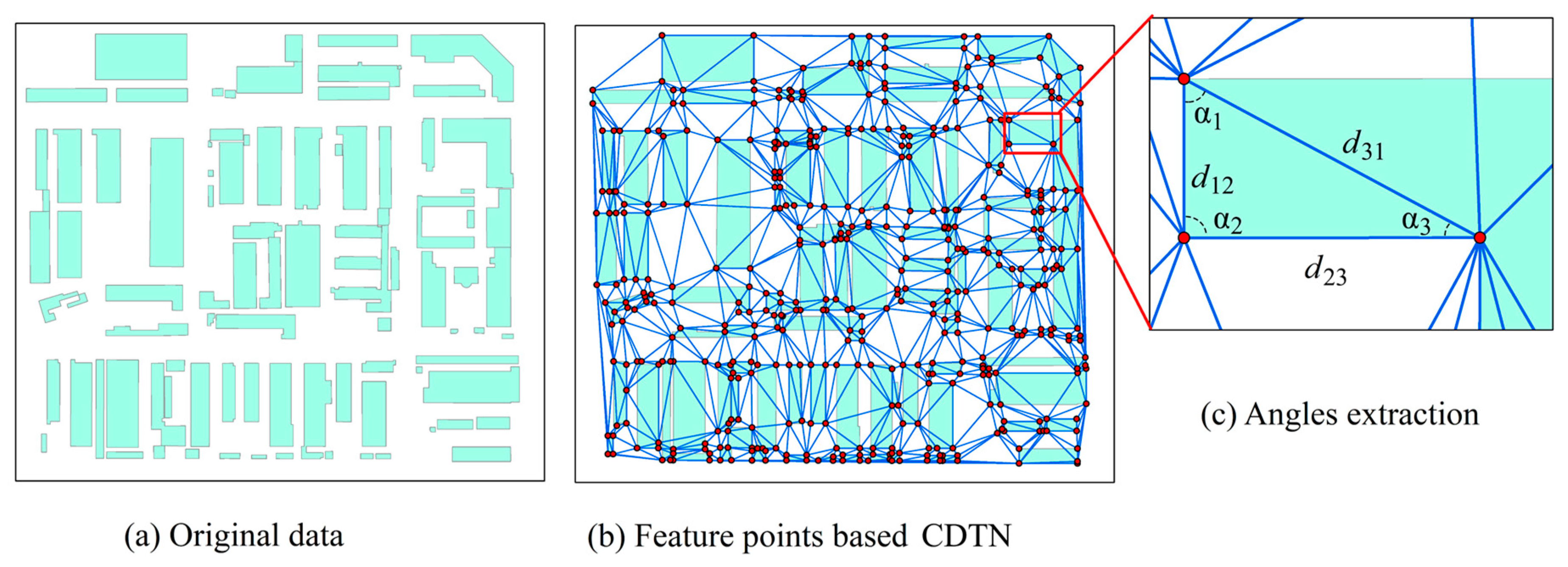
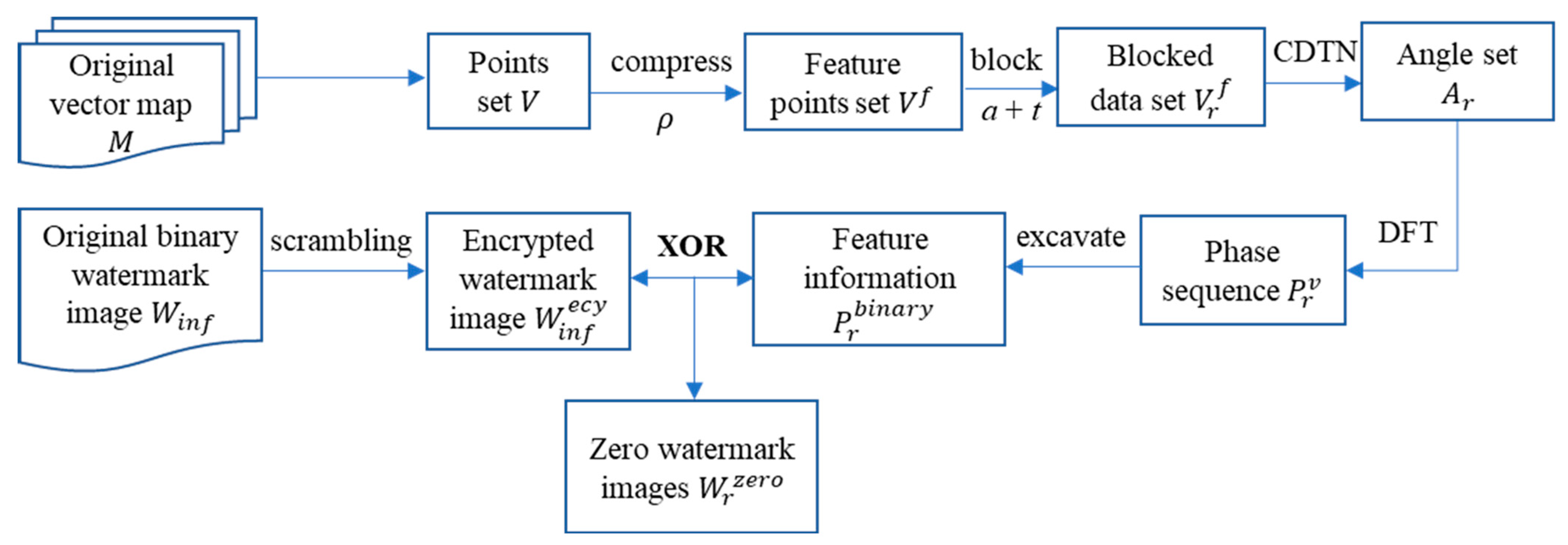
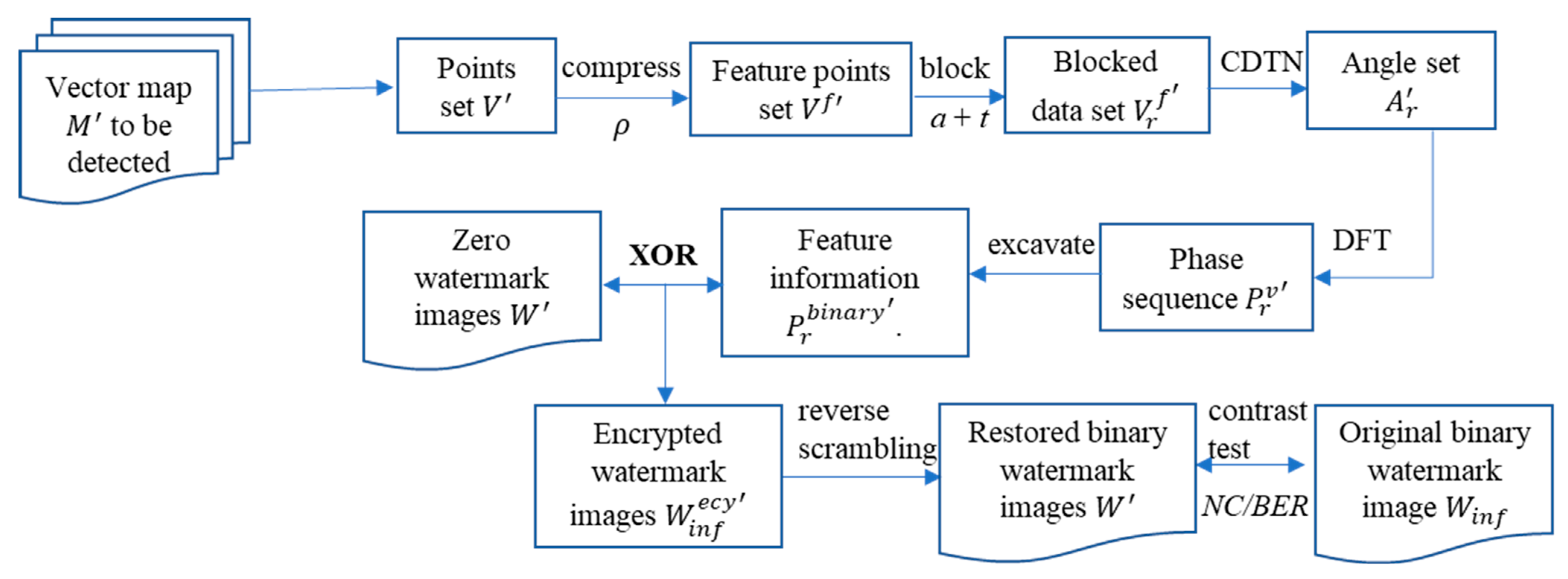


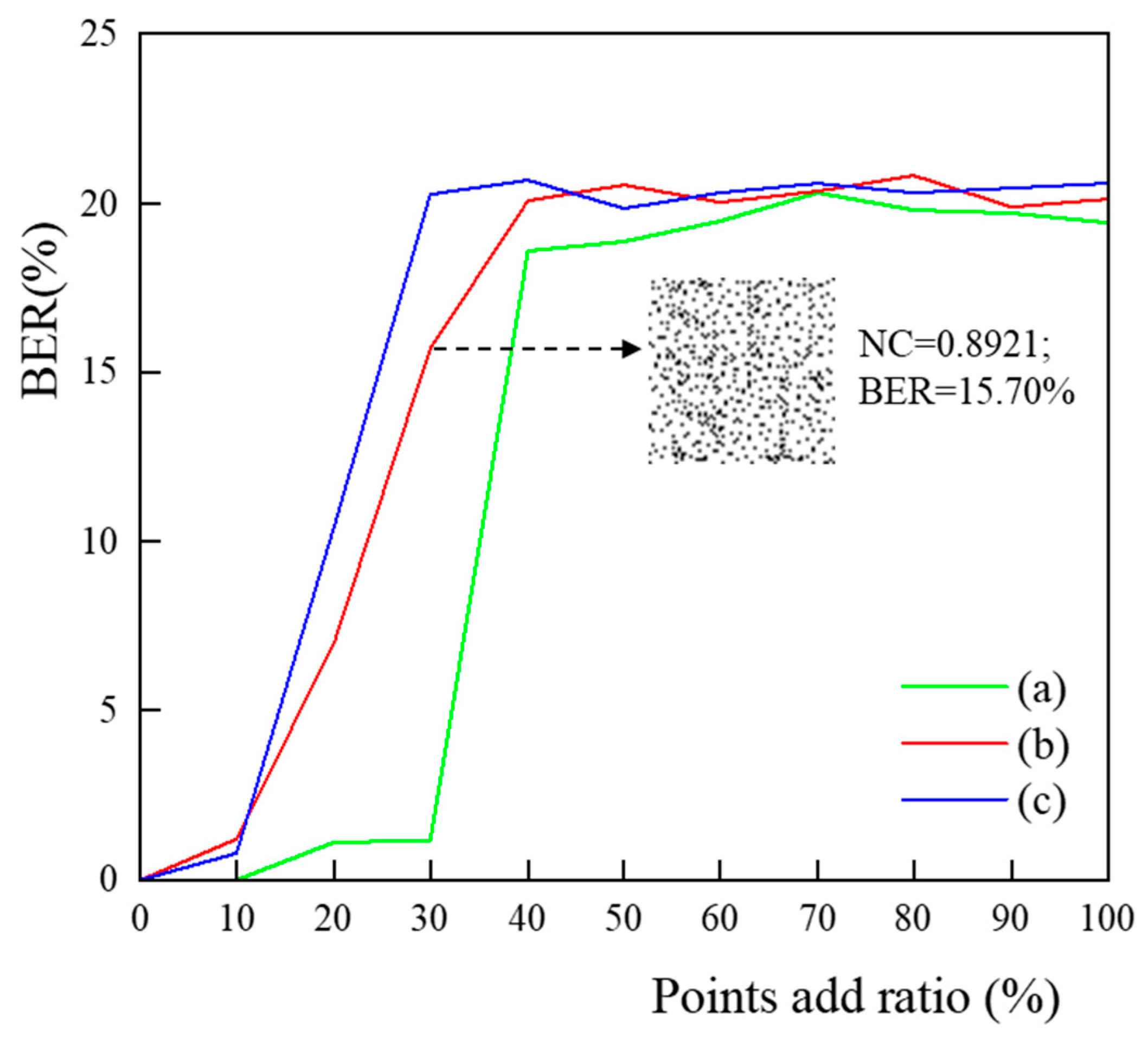
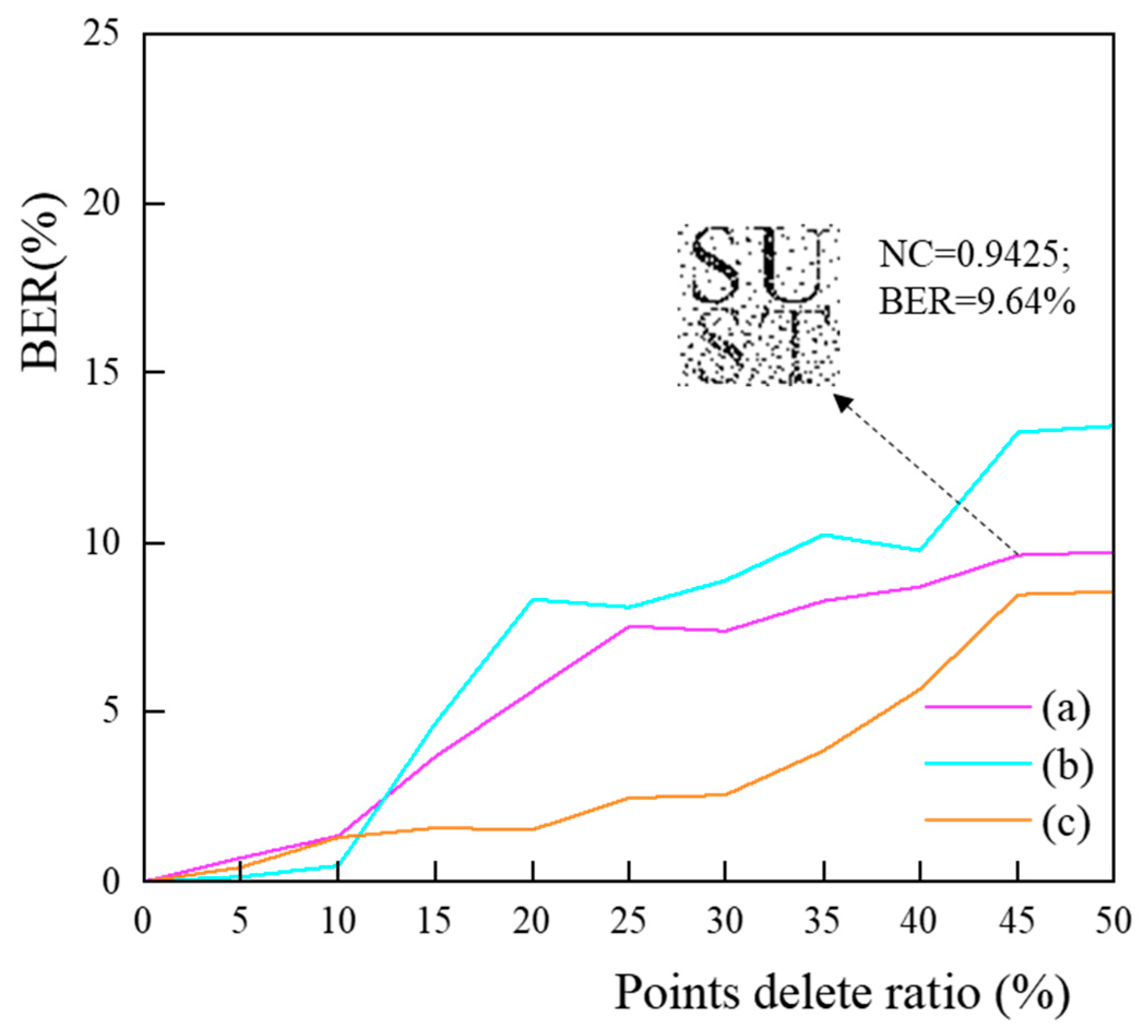
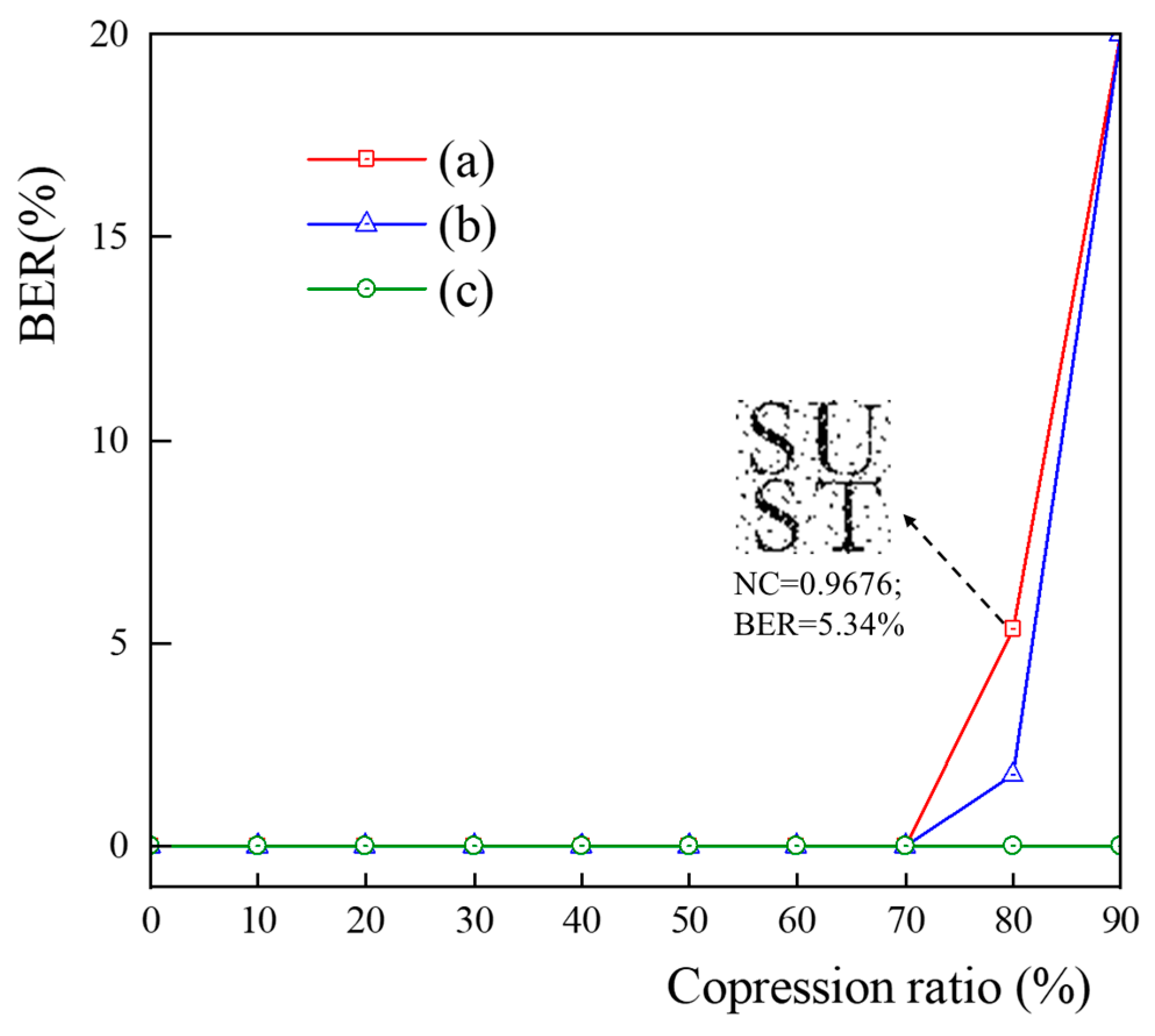
| Data Set | Number of Features | Number of Points | Number of Feature Points | Number of Blocks | Number of Zero Watermarks |
|---|---|---|---|---|---|
| Buildings | 2708 | 61,772 | 15,381 | 23 | 23 |
| Roads | 5115 | 86,367 | 21,237 | 31 | 31 |
| Rivers | 844 | 422,764 | 15,294 | 22 | 22 |
| Attack Mode | Scale | W′/(a) | W′/(b) | W′/(c) |
|---|---|---|---|---|
| Rotation | 30° |  |  |  |
| NC = 1, BER = 0% | NC = 1, BER = 0% | NC = 1, BER = 0% | ||
| 90° |  |  |  | |
| NC = 1, BER = 0% | NC = 1, BER = 0% | NC = 1, BER = 0% | ||
| 180° |  |  |  | |
| NC = 1, BER = 0% | NC = 1, BER = 0% | NC = 1, BER = 0% | ||
| Scaling | 0.5 times |  |  |  |
| NC = 0.9976, BER = 0.039% | NC = 0.9973, BER = 0.044% | NC = 1, BER = 0% | ||
| 2 times |  |  |  | |
| NC = 0.9957, BER = 0.071% | NC = 0.9954, BER = 0.076% | NC = 0.9960, BER = 0.066% | ||
| 5 times |  |  |  | |
| NC = 0.9840, BER = 2.64% | NC = 0.9821, BER = 2.95% | NC = 0.9834, BER = 2.73% | ||
| Translation | 10 m |  |  |  |
| NC = 1, BER = 0% | NC = 1, BER = 0% | NC = 1, BER = 0% | ||
| 20 m |  |  |  | |
| NC = 1, BER = 0% | NC = 1, BER = 0% | NC = 1, BER = 0% | ||
| 50 m |  |  |  | |
| NC = 1, BER = 0% | NC = 1, BER = 0% | NC = 1, BER = 0% |
| Crop Scale | W′/(a) | W′ Count/(a) | W′/(b) | W′ Count/(b) | W′/(c) | W′ Count/(c) |
|---|---|---|---|---|---|---|
| 20% |  | 15 |  | 28 |  | 19 |
| NC = 1, BER = 0% | NC = 1, BER = 0% | NC = 1, BER = 0% | ||||
| 25% |  | 16 |  | 23 |  | 16 |
| NC = 1, BER = 0% | NC = 1, BER = 0% | NC = 1, BER = 0% | ||||
| 50% |  | 6 |  | 17 |  | 8 |
| NC = 1, BER = 0% | NC = 1, BER = 0% | NC = 1, BER = 0% | ||||
| 75% |  | 1 |  | 3 |  | 1 |
| NC = 1, BER = 0% | NC = 0.9577, BER = 6.98% | NC = 0.9522, BER = 7.91% |
| Attack Mode | NCmax/ (a) | W′ Count/(a) | NCmax/ (b) | W′ Count/(b) | NCmax/ (c) | W′ Count/(c) | |
|---|---|---|---|---|---|---|---|
| Geodetic coordinate system transformation | WGS1972 |  | 5 |  | 8 |  | 5 |
| NC = 0.9743, BER = 4.20% | NC = 0.9729, BER = 4.49% | NC = 0.9744, BER = 3.91% | |||||
| WGS1984 |  | 23 |  | 31 |  | 22 | |
| NC = 1 BER = 0% | NC = 1 BER = 0% | NC = 1 BER = 0% | |||||
| Projection coordinate system transformation | WGS1972_UTM_Zone49 |  | 23 |  | 31 |  | 22 |
| NC = 1 BER = 0% | NC = 1 BER = 0% | NC = 1 BER = 0% | |||||
| WGS1984_UTM_Zone50 |  | 18 |  | 19 |  | 13 | |
| NC = 1 BER = 0% | NC = 1 BER = 0% | NC = 1 BER = 0% | |||||
| Attack Mode | Scale | Reference [31] | Reference [32] | Reference [23] | Reference [34] | Reference [40] | The Proposed |
|---|---|---|---|---|---|---|---|
| Rotation | 30° | √ | × | √ | √ | × | √ |
| 90° | √ | × | √ | √ | × | √ | |
| 180° | √ | × | √ | √ | × | √ | |
| Scaling | 0.5 times | √ | √ | √ | √ | √ | √ |
| 2 times | √ | √ | √ | √ | √ | √ | |
| 5 times | √ | √ | √ | √ | √ | √ | |
| Translation | 10 m | √ | √ | √ | √ | √ | √ |
| 20 m | √ | √ | √ | √ | √ | √ | |
| 50 m | √ | √ | √ | √ | √ | √ | |
| Cropping | 20% | √ | √ | √ | √ | √ | √ |
| 25% | × | √ | √ | √ | × | √ | |
| 50% | × | × | √ | √ | × | √ | |
| 75% | × | × | √ | √ | × | √ | |
| Points adding | 25% | √ | × | √ | √ | √ | √ |
| 50% | √ | × | √ | × | √ | × | |
| 100% | √ | × | √ | × | × | × | |
| Points deletion | 2% | √ | × | √ | √ | √ | √ |
| 10% | × | × | √ | √ | × | √ | |
| 20% | × | × | √ | √ | × | √ | |
| Compression | 25% | √ | × | √ | √ | √ | √ |
| 50% | √ | × | √ | √ | √ | √ | |
| 75% | √ | × | √ | √ | × | √ | |
| Coordinate system transform | Geodetic coordinate system | √ | √ | × | √ | √ | √ |
| Projection coordinate system | √ | √ | × | × | √ | √ |
Disclaimer/Publisher’s Note: The statements, opinions and data contained in all publications are solely those of the individual author(s) and contributor(s) and not of MDPI and/or the editor(s). MDPI and/or the editor(s) disclaim responsibility for any injury to people or property resulting from any ideas, methods, instructions or products referred to in the content. |
© 2023 by the authors. Licensee MDPI, Basel, Switzerland. This article is an open access article distributed under the terms and conditions of the Creative Commons Attribution (CC BY) license (https://creativecommons.org/licenses/by/4.0/).
Share and Cite
Xi, X.; Hua, Y.; Chen, Y.; Zhu, Q. Zero-Watermarking for Vector Maps Combining Spatial and Frequency Domain Based on Constrained Delaunay Triangulation Network and Discrete Fourier Transform. Entropy 2023, 25, 682. https://doi.org/10.3390/e25040682
Xi X, Hua Y, Chen Y, Zhu Q. Zero-Watermarking for Vector Maps Combining Spatial and Frequency Domain Based on Constrained Delaunay Triangulation Network and Discrete Fourier Transform. Entropy. 2023; 25(4):682. https://doi.org/10.3390/e25040682
Chicago/Turabian StyleXi, Xu, Yang Hua, Yi Chen, and Qiande Zhu. 2023. "Zero-Watermarking for Vector Maps Combining Spatial and Frequency Domain Based on Constrained Delaunay Triangulation Network and Discrete Fourier Transform" Entropy 25, no. 4: 682. https://doi.org/10.3390/e25040682
APA StyleXi, X., Hua, Y., Chen, Y., & Zhu, Q. (2023). Zero-Watermarking for Vector Maps Combining Spatial and Frequency Domain Based on Constrained Delaunay Triangulation Network and Discrete Fourier Transform. Entropy, 25(4), 682. https://doi.org/10.3390/e25040682





